-
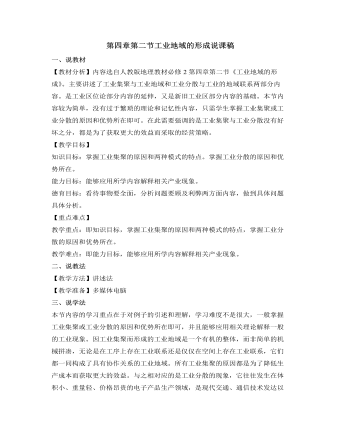
人教版高中地理必修2第四章第二节工业地域的形成说课稿
下面要针对工业地域内部的工业联系进行讲解,这里主要涉及到的是工序上的工业联系。在这段文字的处理上,我会将钢铁、石化、机械加工等工业部门分散成一步一步的工序,便于学生理解这种工业上的联系方式与构造,进而对于工业的发育程度这一概念的理解也就相对简单了。紧接着需要讲述的是工业分散的内容。工业分散是建立在现代的交通运输方式和通信技术与手段上的。它主要针对的是体积小、重量轻、价格昂贵的电子产品生产领域,目的是根据原件的不同性质选择不同的生产地域,利用其各异的优势条件以节省开支。由于案例都是针对高科技产品的生产而提出的,因此在这段教材的教学中我会注意避免将工业分散这一现象描述得更为高级。要让学生明白,无论是工业集聚还是工业分散,它们之间是没有好坏之分的。最后将进行课堂小结,由于本节内容较少且相对简单,可以在最后适当添加部分练习题,重点考察一二两节的相关知识点。

高中历史人教版必修一《第2课秦朝中央集权制度的形成》说课稿
【课件展示】《秦朝中央集权制度的建立》《教材简析》《教学目标》《教法简介》《教学过程设计及特色简述》【师】本节内容以秦代政治体制和官僚系统的建立为核心内容,主要包括秦朝中央集权制的建立的背景、建立过程及影响。本节内容在整个单元中起到承前启后的作用,在整个模块中也有相当重要的地位。让学生了解中国古代中央集权政治体制的初建对于理解我国古代政治制度的发展乃至我们今天的政治体制是十分必要的。 本堂课我采用多媒体和讲授法及历史辩论法相结合,通过巧妙设计问题情境,调动学生的学习积极性,使学生主动学习,探究思考。教师引导和组织学生采取小组讨论、情景体验等方式,达到教学目标。 本节内容分三个部分,下面首先看秦朝中央集权制度建立的前提即秦的统一
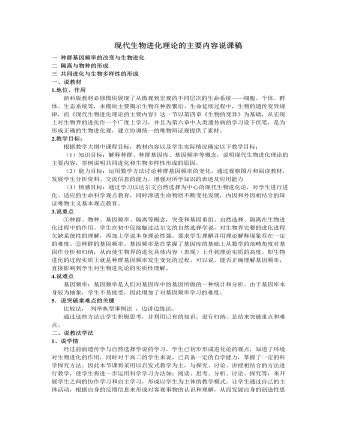
人教版高中生物必修2现代生物进化理论的主要内容说课稿
什么因素可以阻止种群间基因交流呢?由此可引出隔离的概念。学生初步理解隔离的概念之后,可以安排学生讨论隔离的各种可能的方式,教师归纳出隔离的类型。然后组织学生阅读分析教材中的“资料分析”,组织讨论“资料分析”中提出的几个问题。最后教师应强调,一般情况下,地理隔离是生殖隔离的先决条件,生殖隔离一旦形成,原来属于一个物种的两个种群,就成了两个物种。关于“共同进化与生物多样性的形成”内容的教学,可以学生自学为基础,教师提出一些具有启发性的问题,师生共同归纳总结的方式推进教学过程。使学生理解共同进化的含义,无机环境的变化、无机环境的复杂化和多样化、有性生殖的出现和生态系统结构的复杂化和多样化对生物多样性形成的作用。最后,组织学生讨论生物进化理论在发展。
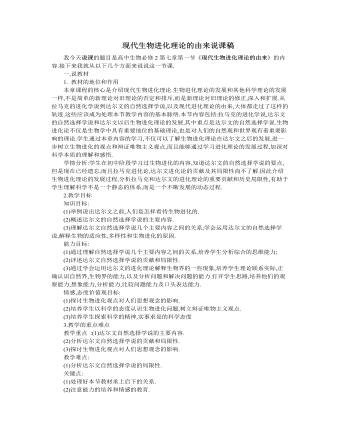
人教版高中生物必修2现代生物进化理论的由来说课稿
一,说教材1. 教材的地位和作用本章课程的核心是介绍现代生物进化理论.生物进化理论的发展和其他科学理论的发展一样,不是简单的新理论对旧理论的否定和排斥,而是新理论对旧理论的修正,深入和扩展.从拉马克的进化学说到达尔文的自然选择学说,以及现代进化理论的由来,大体都走过了这样的轨迹.这些应该成为处理本节教学内容的基本脉络.本节内容包括:拉马克的进化学说,达尔文的自然选择学说和达尔文以后生物进化理论的发展,其中重点是达尔文的自然选择学说.生物进化论不仅是生物学中具有重要地位的基础理论,也是对人们的自然观和世界观有着重要影响的理论.学生通过本章内容的学习,不仅可以了解生物进化理论在达尔文之后的发展,进一步树立生物进化的观点和辩证唯物主义观点,而且能够通过学习进化理论的发展过程,加深对科学本质的理解和感悟.
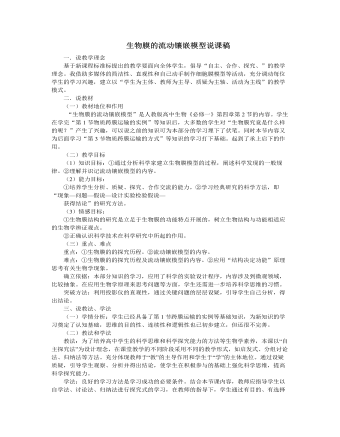
人教版高中生物必修1生物膜的流动镶嵌模型说课稿
二、流动镶嵌模型的基本内容1、膜的成分2、膜的基本支架3、膜的结构特点4、膜的功能特性设计意图:我根据板书的“规范、工整和美观”的要求,结合所教的内容,设计了如图所示的板书,使学生对本节课有一个整体的思路。八、教学反思:本节课我创设了问题情境来引导学生主动学习,利用了多媒体信息技术激发学生的学习热情,调动了学生的积极性,成功实现预期的教学目标。体现了学生为主体地位的新课程理念。启发式、探究式的教学方法以及由教师指导下的学生自主阅读、合作交流的学习方法把学生从死记知识的苦海中解救出来。初次的尝试还存在一定的缺陷,学生不能够很好的把知识和习题联系,只是把他所知道的知识简单罗列,不能够体现出能力的训练。在上课中发现学生比较腼腆或拘束,声音比较小,表达不能到位。尽管本节课存在诸多不足之处,但是也让我看到了闪光点:学生比较欢迎这样一堂自己是主角的课堂。
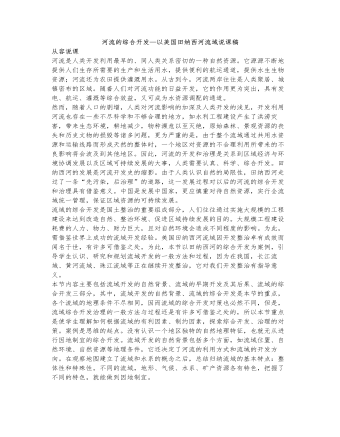
人教版高中地理必修3河流的综合开发—以美国田纳西河流域说课稿
师我国河流众多,长江流域、黄河流域、珠江流域等正在继续开发,出示“长江流域示意图”,请同学们借鉴今天所学的分析方法,分析长江流域发展的自然地理条件。(学生相互交流、讨论)生略。师长江干流全长6300余千米,发源于青藏高原,流经青、藏、滇、川、渝、鄂、湘、赣、皖、苏、沪,奔入东海。水域辽阔,总面积达180万平方千米,流经我国半壁河山。水量汪洋壮阔,多年平均入海近10000亿立方米。流域内总人口、耕地各约占全国的35%,工农业总产值占全国的40%~50%,历来是中华民族繁衍的沃土。流域经过我国三大阶梯,流经青藏高原、横断山脉、四川盆地、云贵高原、长江中下游平原等地形区。流域内水系发达、众多,以亚热带季风气候为主,气候温暖湿润,降水量丰富,河流水量大,水能资源、森林资源、矿产资源丰富,长江干流自古以来就是我国东西航运的大动脉,沟通内地和沿海的广大地区,干支流通航里程约占全国内河航道总里程的2/3,形成了一个纵横广阔的水运网,被誉为“黄金水道”。
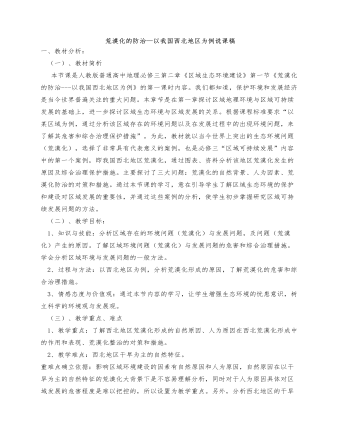
人教版高中地理必修3荒漠化的防治—以我国西北地区为例说课稿
(设计意图: 通过这两个问题探究的形式可以了解学生对二、干旱为主的自然特征这一知识点的掌握情况,随堂练习有利于巩固强化学生的条例性知识。)三、荒漠化的成因1、自然因素:干旱、气候异常2、人为因素:(是荒漠化发生、发展的决定因素)自然原因启发学生利用已经学过的知识(干旱为主的自然特征)和给出的PPT资料来进行分析。人为原因以其危害结果用图表和图片的形式展示,使学生认识到人为因素是导致荒漠化最主要的因素。(设计意图:通过分析自然因素提供学生分析一区域环境建设的自然基础条件,而这也是较难的一点,再者,通过分析人为原因,是学生树立区域生态环境保护意识。)四、布置作业:书本课本20—22的活动—— 非洲萨赫勒地区荒漠化的自然、社会经济
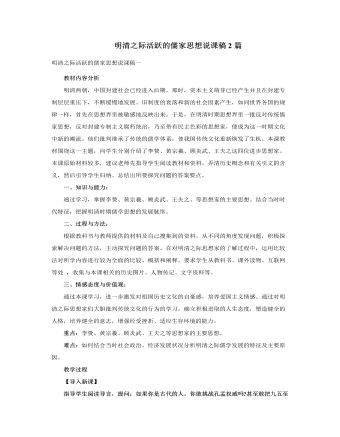
人教版高中历史必修3明清之际活跃的儒家思想说课稿2篇
这是略带提高性的问题,旨在提高学生认识历史的能力,搞清这一历史问题有助于理解中西历史发展的不同。(学生讨论,教师总结归纳并展示。)不是资产阶级民主思想,因为它们是资本主义萌芽的产物,资产阶级作为一个阶级还没有产生。中国民主思想只停留在批判的层次上,并没有提出新的思想,更没有认识到人的基本权利。它没有成为主流思想,因此没有促进明清社会的转型,尚未突破封建思想的束缚。而启蒙思想集中力量批判专制主义、教权主义,描绘了未来资本主义社会的宏伟蓝图,开成了强大的社会思潮,推动了社会向资本主义社会的转变。原因:(1)明清之际的资本主义萌芽较为脆弱,使早期民主思想的产生、发展缺乏强有力的物质基础。(2)中国传统文化的束缚和影响。(3)高度强化的专制中央集权制度的压制使早期民主思想未能形成完整的体系。
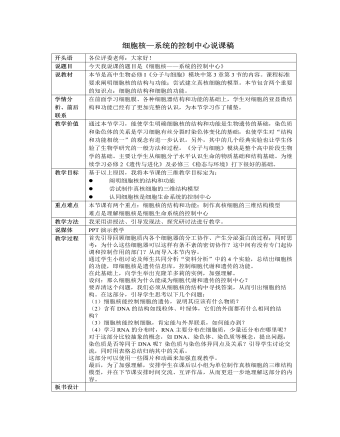
人教版高中生物必修1细胞核—系统的控制中心说课稿
首先引导回顾细胞质内各个细胞器的分工协作、产生分泌蛋白的过程;同时思考:为什么这些细胞器可以这样有条不紊的密切协作?这中间有没有专门起协调和控制作用的部门?从而导入本节内容。通过学生小组讨论及师生共同分析“资料分析”中的4个实验,总结出细胞核的功能,即细胞核是遗传信息库,控制细胞代谢和遗传的功能。在此基础上,向学生举出克隆羊多莉的实例,加强理解。设问:那么细胞核为什么能成为细胞代谢和遗传的控制中心?要弄清这个问题,我们必须从细胞核的结构中寻找答案,从而引出细胞的结构。在这部分,引导学生思考以下几个问题:(1)细胞核能控制细胞的遗传,说明其应该有什么物质?(2)含有DNA的结构如线粒体、叶绿体,它们的外面都有什么相同的结构?(3)细胞核能控制细胞,肯定能与外界联系,如何能办到?(4)学习RNA的分布时,RNA主要分布在细胞质,少量还分布在哪里呢?
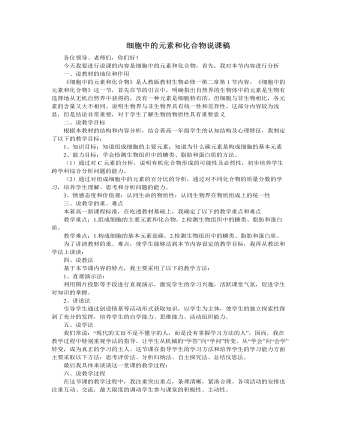
人教版高中生物必修1细胞中的元素和化合物说课稿
一、说教材的地位和作用《细胞中的元素和化合物》是人教版教材生物必修一第二章第1节内容。《细胞中的元素和化合物》这一节,首先在节的引言中,明确指出自然界的生物体中的元素是生物有选择地从无机自然界中获得的,没有一种元素是细胞特有的。但细胞与非生物相比,各元素的含量又大不相同。说明生物界与非生物界具有统一性和差异性。这部分内容较为浅显,但是结论非常重要,对于学生了解生物的物质性具有重要意义二、说教学目标根据本教材的结构和内容分析,结合着高一年级学生的认知结构及心理特征,我制定了以下的教学目标:1、知识目标:知道组成细胞的主要元素;知道为什么碳元素是构成细胞的基本元素2、能力目标:学会检测生物组织中的糖类、脂肪和蛋白质的方法。(1)通过对C元素的分析,说明有机化合物形成的可能性及必然性,初步培养学生跨学科综合分析问题的能力。(2)通过对组成细胞中的元素的百分比的分析,通过对不同化合物的质量分数的学习,培养学生理解、思考和分析问题的能力。
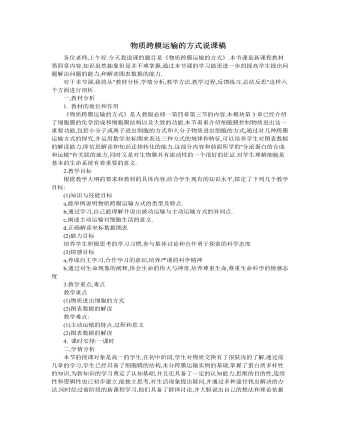
人教版高中生物必修1物质跨膜运输的方式说课稿
(4)提出问题:三种运输方式有哪些异同 组织学生分析填表,反馈和纠正.提出问题:影响自由扩散,协助扩散和主动运输速度的主要因素各是什么 画出细胞对某物的自由扩散,协助扩散和主动运输速度随细胞外浓度的改变而变化的曲线图组织学生分组讨论,并作图,展示各组的成果.教学说明:本环节巩固理论知识是对课本知识扩展和对重点,难点内容的深入理解和总结,只有理解了三种运输方式的异同,才能完成本环节教学任务,既突显书本知识,又培养学生的团结协作的精神,提高学生制做图表的能力和抽象化思维能力的形成.2.大分子的运输引导学生回忆分泌蛋白的分泌过程,得出胞吐现象,提出问题:那大家知道白细胞是如何吃掉病菌的吗 显示有关图片.强调:胞吞和胞吐作用都需要能量提出问题:胞吞和胞吐体现了细胞膜结构的特点是什么 与书本前面知识相联系.(四)技能训练指导学生就《技能训练》部分进行讨论五,反馈练习1.教师小结几种运输方式,特别是自由扩散,协助扩散和主动运输的特点
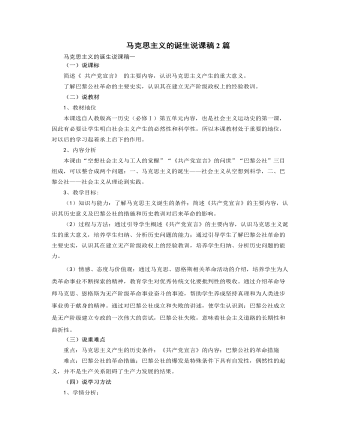
人教版高中历史必修1马克思主义的诞生说课稿2篇
3、马克思主义的三大思想来源之一——空想社会主义理论,教师可以采用多媒体技术、投放幻灯片、人物图片等资料进行处理。这样既能增强课堂的趣味性,激发学生的兴趣,也容易让学生理解什么是“空想社会主义”。可以分别投放圣西门的实业制度、傅立叶的“法朗吉”和欧文的“新和谐公社”等资料加深学生的理解。为了充分发挥学生的学习主体性地位,还可以利用教材中“学习思考”的问题设计:为什么说圣西门等思想家提出的设想是空想的?让学生在教师提供的材料中探究答案。至于马克思主义的另两大思想来源:德意志古典哲学、英国古典政治经济学可以简单处理。而马克思、恩格斯为无产阶级革命事业奋斗的事迹以及马恩两人的友谊是可以稍加扩长的部分,教师可事先布置学生任务,让学生通过网络或者书籍去查找相关知识,也或者由教师在课堂上补充相关资料,调节课堂气氛。

人教版高中生物必修1物质跨膜运输的实例说课稿
(四)、成果交流教师出示成熟植物细胞图,提出原生质层的概念,小组交流,教师点拨,得出结论:1、原生质层相当于半透膜2、外界溶液浓度大于细胞液浓度---细胞失水(质壁分离)3、外界溶液浓度小于细胞液浓度---细胞失水(质壁分离复原)教师出示有关细胞选择性吸收离子的数据资料。引导学生发现并探究出不同植物对同一离子吸收量不同,同一植物对不同离子吸收量也不同,得出结论:4、细胞膜具有选择透过性(五)拓展延伸如何用已有知识和技能鉴别两种蔗糖溶液浓度的大小?用0.1g/mg 0.8g/mg的蔗糖溶液分别做前面的探究实验会有什么不同的结果?你得出的结论是什么?引导学生总结出发生质壁分离和质壁分离复原的条件。五、板书设计好的板书就像一份微型教案,此板书力图全面而简明的将授课内容传递给学生,清晰直观,便于学生理解和记忆,理清文章脉络。
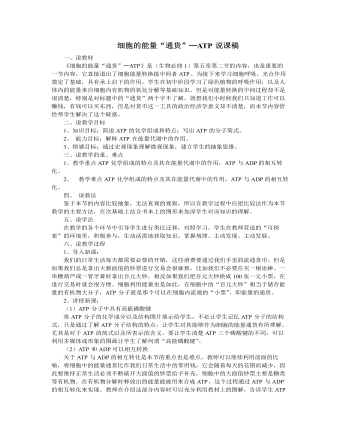
人教版高中生物必修1细胞的能量“通货”─ATP说课稿
(3)ATP的利用关于ATP的利用,一是要讲清楚吸能反应和放能反应与ATP的分解和合成的关系,二是要充分利用教材上的图解,让学生在看懂图解的基础上,讨论ATP还有哪些用途,从而对该图解进行补充和完善。3、课堂小结,强化认识。ATP作为能量的“通货”,在生物体生命活动中具有重要的意义。我们不仅要知道ATP的分子结构,还要掌握ATP是如何行使他的货币能力。4、板书设计结束:本节课设置了一系列问题情境,层层设问,在学生答问、质疑、讨论过程中让学生建构新概念和新的知识体系,并通过教师及时掌握反馈信息,适时点拨、调节,让学生在推理判断中培养良好的思维习惯和对知识的迁移能力,而且通过留出一定的时间让学生提问,体现了以学生为主体的思想。我的说课完毕,谢谢大家。
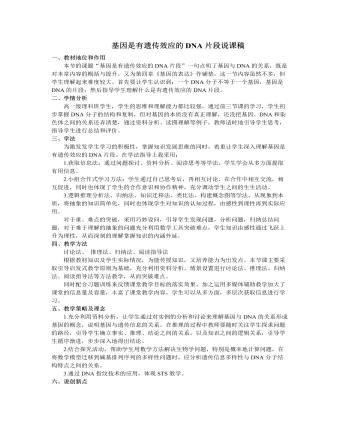
人教版高中生物必修2基因是有遗传效应的DNA片段说课稿
1.基因的化学组成:每个基因含有成百上千个脱氧核苷酸。讲述:基因的脱氧核苷酸排列顺序代表遗传信息。2.基因不同的实质:不同的基因,四种脱氧核苷酸的排列顺序不同,但是每个基因都有特定的排列顺序。3.基因的位置:染色体是基因的主要载体,每个染色体含有一个DNA分子,每个DNA分子含有多个基因,基因在染色体上呈直线排列。4.基因是有遗传效应的DNA片段这就是说,基因是DNA的片段,但必须具有遗传效应(指具有复制、转录、翻译、重组突变及调控等功能)。有的DNA片段属间隔区段,没有控制性状的作用,这样的DNA片段就不是基因。控制某种性状的基因有特定的DNA片段,蕴含特定的遗传信息,可以切除,可以拼接到其他生物的DNA上,从而获得某种性状的表达。例如:把牛的胰岛素基因拼接到大肠杆菌的DNA上,大肠杆菌可以生产胰岛素。
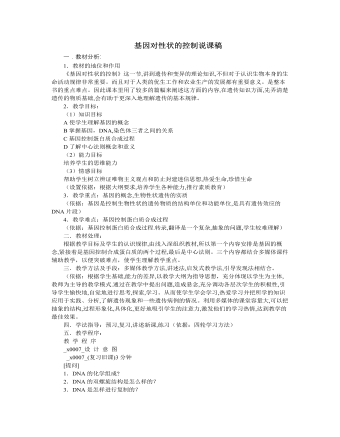
人教版高中生物必修2基因对性状的控制说课稿
7.让学生阅读基因控制蛋白质合成的过程(转录,翻译)13分钟 动画演示“转录,翻译”过程两次,让学生有个整体印象。 培养学生自学习惯,突出教学过程中的学生为主体的教学思想。 8.配合动画引导学生根据预习逐段讲解。 注意问题(1)转录,翻译的地点,模板,生成物不同。因为这是一个极其复杂的过程,避免学生在学习过程中相混肴.(2)这个问题的阐明能为后面“密码子”的概念做好铺垫,避免学生搞不清“遗传密码”和“遗传信息”两个概念。 9.打出板书。 通过动画演示,加深学生的理解和掌握,提高学习效率。 10.重播全过程动画,引导学生讲述。7分钟 _x0007_加深认识,完成从量变到质变的飞跃。 11.过渡:就这样,以DNA为模板合成信使RNA,再以信使RNA为模板,以转运RNA为运载工具,使氨基酸在核糖体中按照一定的顺序排列起来,合成了与亲代一样的蛋白质,从而显现出与亲代同样的性状。从而引出“中心法则”。

人教版高中生物必修1细胞器—系统内的分工合作说课稿
②与学牛的牛活经验相关,有利激发学列的兴趣。⑧利用多媒体让学牛通过观看、比较、讨论,加深理解f-J利掌握细胞内的牛要细胞器的结构及其功能。④学牛白丰学习,丰动建构新知识。⑤为完成后面的达标图表做充分的准备。4、概括反馈:①设讣达标表格,引导学牛完成。②应用该表格进行小结。③推荐相关网站,以解决课后遇到的附加题。这样设置的理由是①通过完成表格,归纳各种细胞器的结构和功能,使学牛更好的掌握本节课的内容。②培养学牛的分析问题和归纳总结的能力③培养学牛的竞争意识和团队合作精神。④拓展了教育资源,为学牛提供了一个白丰学习的空间。[课堂小结]请4-5位学牛来总结本节课的学刊内容和白己掌握的情况。请教师重新出示“八种细胞器的比较表”和“植物细胞和动物细胞的比较表”对本节内容的知识点、重点、难点进行总结。

人教版高中生物必修1ATP的主要来源—细胞呼吸说课稿
(一)自主阅读:自主阅读有氧呼吸三阶段内容,明确有氧呼吸的场所、反应物、生成物和释放的能量状况等内容。(二)直观教学:通过多媒体辅助教学软件,化静为动,化抽象为具体, 增强了教学内容的直观性和启发性。 .(三)比较法:学生参与完成有氧呼吸三阶段区别的表格,进行教学反馈;比较有氧呼吸和有机物体外燃烧的不同,进一步认清有氧呼吸的特点。(四)归纳法: 归纳有氧呼吸的概念。三.教学过程分析步骤一: 导入新课 通过问题探讨导入本节内容第三节 ATP的主要来源 ——细胞呼吸步骤二: 联系生活(酵母菌可用于发面和酿酒) 介绍细胞呼吸概念一、细胞呼吸的方式 :有氧呼吸、无氧呼吸步骤三: 回顾第三章细胞器的知识,学习 二、(一)有氧呼吸的主要场所——线粒体的结构

人教版高中生物必修1细胞膜—系统的边界说课稿
(1)问题串设计:①选材:选择什么细胞做材料?②为什么选择哺乳动物成熟的红细胞做实验材料?(在教师的指导下讨论分析)③怎样才能获得细胞膜?(教师讲授)(2)指导学生观看多媒体播放教参CD中的这个实验,同时教师加以讲解(3)学生分组实验(4)总结实验并加以评价设计意图:体会实验材料的正确选择对于科学研究的重要性,提高学生科学研究素养。学生在已有知识的基础上思考,尝试找出实验的原理,实现亲身体验、自主思考的的过程,这样加深学生的印象。培养学生拓展迁移的能力,使学生认识先进的生物学研究仪器。环节3.细胞膜的功能(1)学生自主学习并归纳总结:P42(2)展示图片加强理解:图片(3)讨论:联系生活实际,列举现实生活中有什么东西与细胞膜的功能相近?设计意图:提高学生自主学习的能力;注重与现实生活的联系,引导学生利用类比的方法解决问题,便于学生理解和掌握。环节4. 植物细胞的细胞壁
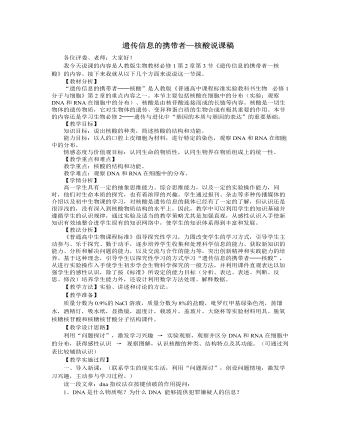
人教版高中生物必修1遗传信息的携带者—核酸说课稿
二、问题导学,主动探究,获取知识:(给学生机会,参与学习过程,有利于对知识的感知和对科学研究方法的领悟。有利于突破难点。)通过上面的讨论及对初中相关知识的回忆可知,核酸是生物体内的遗传物质。提问:1 、你知道生物体内的核酸有几种?它们在细胞中是如何分布的? 2 、如何观察核酸在细胞中的分布? 针对问题,引导学生阅读教材及相关实验内容,组织学生进行实验。让学生阅读课文及“观察DNA 和RNA 在细胞中的分布”实验,回答问题。实验后要倾听、总结学生的实验结论,继续引发学生思考:原核细胞的DNA位于细胞内的什么部位?三、加工、整合信息, 构建知识体系。(充分利用教材中图示和课件的直观性特点,发挥学生主体作用,引导学生通过观察、讨论,感知知识的形成,突出重点)组织学生阅读教材并讨论: 1、核酸同蛋白质一样,也是生物大分子物质,那么,核酸由哪些元素组成?组成它的基本单位是什么? 2、DNA 和RNA的化学组成有何异同? 3、组成核酸的碱基、五碳糖、核苷酸各有几种?